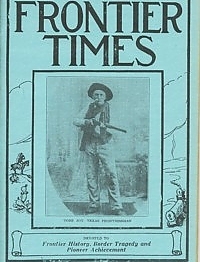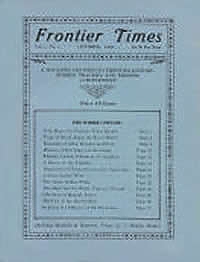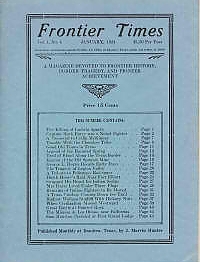By using our website, you agree to the use of cookies as described in our Cookie Policy
Magazines & Instant Downloads
Vol 08 No. 08 - May 1931
On the cover: Tobe Joy
Texas Once Had A Navy
The Texas navy was created in 1835 when Henry Smith was the provisional President of the Republic. There were three armed schooners in the little flotilla, but they made the Mexicans tired of life along the Gulf coast. They preyed upon Mexican commerce, raided coast, settlements, and with their captured booty and supplies did much to maintain the Texas military establishment, aside from supporting themselves. This little navy was gradually strengthened until in 1840 it numbered six good staunch fighting ships. This is a brief account of that force.
Further Mentions: Commodore Edward Ward Moore* flagship Austin* the Zarallo* the San Antonio* the San Benard, and the brig Dolphin* General Sam Houston
Charles Binion's Life Was Epic Of Early Days
In the scope of the life of one man, Charles Binion, the free range epic of the cattle country can be epitomized. He was the typical cowhand, almost born in the saddle and living always in the atmosphere of trail herds, remudas, round-ups and branding irons.
Billion was born in Uvalde County, in Southwest Texas on tire Rio Frio river about 1845. It was the region from which the great migration of cattle were to come after the Civil War, a country of rancheros and cattle from Binion's earliest recollections. His father was one of the early settlers in the days of Houston and Austin. His mother was of the fine Southern type that formed the bulwark of the struggle of the Texans for independence. This is the account of his story.
Further Mentions: Phil Spear, Lodge Grass stockman* the big outfits such as the O. R. O. and the Corletios* the Metador and X. I. T, outfits* Billy the Kid and Billy's mother and was acquainted with Luke Short, King Fisher and Bat Masterson. Of them all, Luke Short was his favorite* For the last 20 years of his life Binion worked on the Crow reservation, where large leaseholders and the big cattle outfits of Frank Heinrich, Spear Brothers and, the Dana Cattle Company still kept some semblance of the balmy days when, from the Rio Grande to Calgary, the cattleman was supreme. He also found employment with the I. D. herd* Lodge Grass* the Spear outfit* Nearly all the prominent characters who took part in the Lincoln County war were known to Binion* the R. L. (Ryan Brothers) Flying E (Hysham Company), and 7 Bar 7, (McCormick) in Montana and the Three Vs in Dakota* Orin Junction near Laramie, Wyo
Pioneer West Texan Passes To Her Reward
Account of Mrs. C. Baker notable pioneer woman of Medina County and Menard County. She was born April 16, 1840, in Monroe County, Tennessee. She was married to Claborne Baker at 18 years old, and She led a life filled with many and varied experiences, such as the time an old Indian Chief came to the house where he saw the baby wrapped in a red blanket. He stood for a while hacking on the door facing with a butcher knife, while Mrs. Baker stood nearby with her weapon, a hatchet. The old Chief finally turned and went away.
Further Mentions: Rev. M. H. Keen* the Pioneer Rest Cemetery* Captain Mountain* Roswell, New Mexico* Captain Lee* two daughters and four sons. They are: Mrs. J. A. McWilliams of Mason ; Mrs. C. W. McCurdy of San. Antonio, J. D. Baker of Glen Cove; J. M. Baker of Menard and O. D. Baker of Menard.
Kansas City Woman, 109, Dies
Story of Mrs. Emma (Grandma) McMahon who was Born in England and was brought to this country as a child. Her father, a seaman, settled near Milwaukee, but the call of the sea came to him again and he left his wife and children to return to the ships. When she was 3 years old, Indians raided the village where the family lived. Little Emma was carried away. A squaw noticed her bright blonde curls and begged that the child's life be spared. So for years she lived among the Indians, witnessing the rigors of` the wild life, hardly recalling her white parentage. Another white woman was captured one night, dragged to the Indian camp bound hand and foot, and bundled carelessly into one of the lodges. Emma had seen the woman brought in and that night she crept, while the camp slept about her, to the lodge and slit the ropes that bound the captive. Together they fled into the night. There followed hours of fear and pain, hours during which they walked painfully toward civilization, thrown into panic by the cries of animals about them. But they arrived safely. Weeks later Emma was able to rejoin her family. She was a great woman and this is her story.
Further Mentions: Patrick McMahon* Mrs. Emma Van Gofre.
GEORGE WASHINGTON BRANDED HIS CATTLE
Senator Tom Tonnally, who hails from Texas, the greatest cattle state in the country, has made, according to the Division of Information and Publication of the George Washington Bicentennial Commission, an exhaustive study of George Washington's experiences in producing and handling cattle. He reveals that Washington's Diaries read as follows "Nov. 1, 1765- Sent one bull, 18 cows and 5 calves to Doeg Run in all -24 head branded on the buttock GW. Sent 5 cows and 29 yearlings and calves to the Mill, which with 4 there makes 27 head in all viz. 5 cows and 22 calves and yearlings branded on the right shoulder GW. Out of the Frederick cattle made the stock in the Neck up to 100 head -these branded on the right buttock GW. `Muddy Hole cattle branded on left shoulder G. W.'
Further Mentions: Mrs. Bassett* Mr. Kirkpatrick* Mr. Dalton* Colonel Fairfax* Colonel Cock's cattle* Mr. Peake* Abingdon
ORIGIN OF NAME "TEXAS"
There has been much discussion over the origin of the name "'Texas" and several theories have been advanced. The Texas Almanac, published by the Dallas News, whose compilers have given much study to the matter, has this to say in its latest volume on how the name originated: "That the name came from the Indian tribe of Tejas is granted, but how the Spanish came to refer to them as Tejas is another matter. It frequently is stated that the word meat "friendly" or "hospitable." Possibly so. Attention has been called to the fact that the Spanish word "Tejas" means roof tiles. There is a story that those Indians lived in houses roofed with tiles. Again, possibly the application of the name was purely figurative. In nearly every language some form of reference to the word roof connotes hospitality. So there may be some basis for the story that the name of Tejas was applied by the Spaniards to the Indians because they were friendly; these Indians, it has certainly been established, were peace-loving soil-tillers. unlike the warlike nomads of the West Texas plains, and lived in relatively permanent structure."
John C. Ware, Uvalde County's Oldest Settler
Here is some fine old Uvalde co. history!
By Aileen Fenley. Account of John C. Ware, Uvalde County's oldest settler, Indian fighter, ex-Ranger and veteran of the Civil War. As a youngster John followed his first Indian trail, despite the pleadings of little sisters, for that dare-devil spirit of adventure and fearless bravery necessary to cope with the trials and dangers of frontier life in which the panther and the Indian viewed as horrors, was in this lad of 14. To that race of Scotch-Irish frontiersmen that aided in; pushing the frontier belt steadily westward until the frontier was no more belonged Capt. William Ware, the father of John C. Ware. Born in Kentucky in 1800, Capt. Ware first came to Texas in 1828, and settled on Ware's Creek in Montgomery County. It was here that his son, John, was born July 20, 1839. His wife, Betsy Ann Crane, was the daughter of Capt. John Crane, who was killed in a battle against Chief Bowles of the Cherokee Indians and for whom Crane County takes its name.
It was but a few months after his father's death that John. C. Ware rode his first Indian trail, Gideon Thompson, living at the head of the river, had several horses stolen from him one night by Indians. The next morning lie started in hot pursuit, gathering his neighbors along the river as he went. When he reached the Ware homestead, young John begged to go, and the party consented. Running to the house to get his rifle, he met the weeping protests of his six sisters. But John was determined to go, and finally the old negro mammy said to the girls, "Chilluns, you might as well stop crying and let him go. He's jest like his ole father befo' him,' and the devil can't stop him!" Thus rode down the Sabinal valley 14-year-old John Ware on his first Indian trail.
Further Mentions: the village of Utopia* the ruins of his old homestead which was destroyed by fire, in the old town site of Waresville* Capt. Ware's father was Joe Ware, a gunsmith, who made guns for Washington's army* the old Veramendi house on Soledad Street in San Antonio* Col. Ben Milam* Capt. William Ware, who was the first white settler of the Sabinal valley in Uvalde County, and in whose honor the first village, Waresville, received its name* The two-story house of Hollis Fenley, the son of Eliza Ann Ware Fenley, a daughter of Capt. William Ware* Kaufman County* his son, John. and six girls Sarah, Eliza, Ann, Amanda, Texanna, Emily and Betty* York's Creek, 12 miles southeast of New Braunfels* the death of his wife, Betsy Ann Crane, Dec. 20, 1849* Capt Ware purchased a farm on the Cibolo* Fort Lincoln* By 1853 the families of Gideon Thompson, Henry, Robinson, Aaron Anglin, John Fenley and Joel Daniel Fenley had arrived* Sarah Ware Kincheloe* the Ranger band organized by John Davenport* in a battle on the Leona River* Company B of Duff's Regiment* After the death of his first wife, John Ware married Miss Mattie Bates* Mrs. Emmaline Ware Holderness* Joel Ware, Utopia; Ira and Oscar Ware, New Mexico; Berry Ware, Sabinal; Media Ware Fenley, Sanders, and Mrs. Agnes Ware Woodward, Wichita Falls.* R. H. Kincheloe* Eliza Ann married Joel Daniel Fenley* Mrs. Minnie Miller, Utopia and Sabinal; Mrs. Harvey Donoho, Sabinal; Mrs. Gaylord Keeper, Elizabeth, La.; George and the adopted son, Bobby Ware of Utopia.
The Old Cartridge Belt
Mrs. B. E. Pedrick. In this story, Mrs. Pedrick reminisces of the old cartridge belt that belonged to her father, P. H. Coates, pioneer and early settler on the banks of the Leon River in Correll county, in the early 1870’s. She images the scenes that the old belt witnessed around the life of her father as he started out in his career as a cowboy, following the trails of the long horn cattle. And if the belt could speak it would tell of the unsettled plains and hills into Taylor county, where for years, he rode the timbers along Jim Ned Creek, across that beautiful broken country around Buffalo Gap. It could tell us of a worn narrow trail winding its way up Morro Mountain, where he rode to locate cattle with his field glasses. Or it could point out some old rock walls near Coyote Creek where there used to be a saloon and where the boys went to spend their evenings while the chuck wagons were camped near…etc.
Further Mentions: a little draw down there filled with scrub brush and rank grass, near where Tuscola now stands
Judge Duval West To Retire
Story of Federal Judge Duval West of the Western District of Texas, who was appointed Federal Judge in 1916 by President Woodrow Wilson, began his service as Judge on January 1, 1917, and who served almost fifteen years with distinguished ability. Judge West lived a colorful life as a ranchman, Deputy United States Marshall, a lawyer and as a judge. This is his story.
Further Mentions: United States Marshall John Rankin* With J. S. McNeel, later a captain of the Texas Rangers* Bill Whitely* Harwood* Ed Sarano* Dan Toomey, the engineer* Floresville* Marshal Frankin
THE BATTLE CREEK FIGHT
Brief account of the fight under what is called the twin oaks on the top of a hill, near where twenty-one men were killed in what is referred to as `Battle Creek,' near to Highway No. 31, between Hubbard and Dawson, in Hill county, TX.
Further Mentions: John Hoffer, of San Angelo, Texas* Robert P. Cox* Mrs. Mollie E. Griffin* Euclid M. Coke, Tom Barton, Sam Allen* Ingraham, J. Hand, A. S. and A. T. Mitchell, J. Neal, W. M. Tremier, J. Bullock, N. Baker, A. Houston, P. M. Jones, Dave Clark, and those escaping as Walter P. Lane, W. F. Henderson, Vislett, Button, Smith* S. Kirgan
The Adventures Of Big-Foot Wallace
By John C. Duval. First Published in 1870 (Continued from last month)
"Bigfoot" Wallace is one of the front ranking characters of Texas pioneer history. He is legendary as a soldier, settler, frontiersman and general all-around Texas character. A descendant of the great Wallace and Bruce clans of the Scotland, he carried on their zeal and nobility as a freedom-lover and a freedom-fighter. This excellent history of Wallace by John C. Duval was first published in 1870, and is therefore very close to the events that occurred in conjunction with the great man’s life. You will love reading these pages, and if you need the other 14 installments of this story, just let me know.
This installment mentions further: General Mexier * Rancho Salado* Colonel Barragan* Colonel Ortez* The drawing of the beans * Shepperd* San Luis Potosi* Queretaro
The Border Sheriff Now Speaks For Himself
Horatio Lankford King. King, records this personal interview he had with famous Texas border sheriff, J. K. P. Lankford, who served for many years on that long strip of rich territory, from Port Isabel on the coast of the Gulf of Mexico, to El Paso, in the Far North.
Further Mentions: Martin and Henry, and there was Dillard and Victor Sebree * Philipe Guerra* the bank in Camargo* Bill Cruz and his desperado gang* Ranger Dillard* Pena Station
Pistols Recall Manhunt For Espinosa Brothers
Further Mentions: They committed their first murder on the headwaters of Hardserabble Creek in the Wet Mountains some miles south of Canon City, where they shot an elderly man named William Bruce* Their next victim was Henry Harkness* Dead Man's Canyon* South Park* California Gulch* Lehman Seyga* Captain John McConnan* Espinosa Peak* Tom Tobin, a scout, a veteran of the fur-trading days and all-around frontiersman of note, * Fort Garland*
An Old Timer In Reminiscent Vein
These are the reflections of Mr. Powell Roberts, who was personally familiar with many of the foremost frontier persons and events of Texas Pioneer history. He recounts many events in Kimball, Dawson, Johnson, Palo Pinto counties as well as events and places such as… Ben M. Roberts * Jeremiah (Jerry) Roberts* Joseph Benton Roberts* Ben McCulloch* Jack Mabry* Belmont* Lockhart* Abbie Roberts* Holloway and Jonathan Ellison* Captain Dan Roberts of Austin* These Ellison families came from Mississippi to Caldwell county, Texas, in ox-wagons in 1849* Alexander (Buck) Roberts* James F. Ellison, a son of Jonathan Ellison, was one of Texas' big trail drivers in the early days, and located at Marfa forty-five years ago, where he had a cattle ranch* Uncle Billie Slaughter. The name Slaughter in Texas has been associated with cattle since early days* Lim (C. C.) Slaughter* Landrum Harris* The town of Mineral Wells* a man named Glass Hill* the Lazy S. Ranch* Lum Slaughter* Henry Perkins* Charley Wilson* fellow by the name of John Coffee* John Cain* Tom Duff* Pat Wooding* Belknap and Fort Griffin* Junction City* Mart Cadell, Bill Robertson. George Graves, Old Man McLemore* Ben Thompson* Jack Harris* King Fisher* Marvin Powe* a man named Fine Gilleland* Manning Clements* the Glass Mountains * Ranger Felix Cook and Deputy Sheriff Putman * Joe Erwin * people who lived in Kimble county in 1882, the Gilmores, Moss, the Hankins, Glass, Tomberlin, Joe and Zack Wood, Cadell, Graves, Joe Meek, Ames, Snyder, Crenshaw, Stewart, the Taylor and Joy families * The brands some of the cattle wore were HBT. 70L, J5, and SO.
Red Jacket
During the Revolutionary War the Seneca Indians joined forces with the British. Chief Red Jacket opposed the action his tribe took, was not in sympathy with the British, still much against his will, in order to avoid confusion among his tribe he enlisted in the British army and because of his ability and faithfulness one of the British officers gave him a bright, scarlet jacket, which when worn out was replaced by another of the same color. Because he wore these jackets all during the war and also because his Indian name was long and hard to pronounce, the British named him Red Jacket by which name he was known the remainder of his life. This is his story.
The Coalson Massacre
Mentions: Mr. J. Blaylock of Barksdale, Texas * Captain Dan W. Roberts' Company of Rangers * Dove Creek * Fort McKavett * Reuben T. Anderson, Geo. R. Bingham, Nick Brown, Tom A. Carson, S. D. Coalson (son of Nick Coalson), Lewis H. Cook, Mart E. Coyle, and Dock Gourley * Ira L. Wheat, S. B. Rainey * R. T. ANDERSON
FIRE CARRIED FROM WEST VIRGINIA TO TEXAS
A. C. Brown, of Aledo, Texas, tells the story of how his father and family brought fire all the way from West Virginia to Texas in a pot. The journey was made in 1856, in covered wagons, and required nine weeks. And for those nine weeks an iron pot formed the hearth upon which the embers were kept glowing during the covered wagon journey. It was before the days of matches, and ready means of making fire were not always at hand. So each morning when the night's camp was deserted, the embers of the fire were gathered up and placed in the iron pot, and a protecting covering of ashes placed over them so the precious spark might not die before the day's journey was ended.
CARVES STEER HEADS
Death Valley
George F. Paul. Back in 1850, when there was a steady stream of fortune hunters bound for California, one trail led down through Utah, Nevada and Southern California, and on to Los Angeles. Most of these emigrant outfits had huge prairie schooners drawn by oxen. One of these bands reached Ash Meadows in Nevada, not far from the California line. They had found springs of water at such intervals that they had been able to keep their animals in condition to work in spite of the heat but their situation was swiftly becoming desperate. The mountains were becoming more precipitous; the canyons more obstructed with the debris of tornadoes. From then on the articles that they threw away to lighten their burdens told the history of the expedition.
Soon the Funeral mountains reared their huge bulks to block their progress. Following a torrent bed up between two peaks, they found themselves overlooking a deep valley with rugged walls. The salt marsh in the distance looked like an inviting lake. They were compelled to use ropes and chains to lower their wagons to the mesa at the foot of the ridge on which they stood. Then the night came upon them and found them without water. It was a restless night-the cattle bawled, children cried, men and women grew fretful. There was no water to drink.
At the first streaks of dawn the leaders were up and eager to find two things-water and a pass through the snow-capped rage that rose to the west. Under the burning rays of the pitiless sun the searchers became frantic and soon delirious. They began to separate into groups of three and four. They spread out to the north and to the south along the bare face of the Panamint mountains, walking over sand so hot that the…
Further Mentions: the Argus range * Mrs. Towne * one of the survivors, Asa Bennett * the Gunsight lead * Dr. Darwin French * Furnace creek * old lead-smelting furnaces used by the Mormons * W. T. Henderson * Aaron Winters * In 1880 Winters was living with his wife, Rosie, in Ash Meadows, to the east of Death Valley
How The Brazos And Colorado Originated
J. T. Merchant. Account mentions: `An Indian Legend of the Flood,' signed by James Spillane. * the Caney (Old Caney) * Carancas * Lipans * Ripans * Wacos * Caranchuas * Tawakonies * Mr. E. J. Little * Mr. Spurr * the Marathon Fold
PIONEER WHO LEFT TOMBSTONE IN HAIL OF LEAD RETURNS TO FIND ARIZ. CITY PEACEFUL
Story of John P. Chum, mayor of Tombstone, made his exit from the uproarious town in a hail of lead due to uncontrollable lawlessness and even the efforts of Wyatt Earp , were futile. This is the brief account of that desperate fight involving: Virgil Earp * Wyatt Earp * Morgan Earp * "Doc" Holliday * Ike and Billy Clayton, Frank and Tom McLovery, and Billy Claiborne
$4.95
‹ Back








